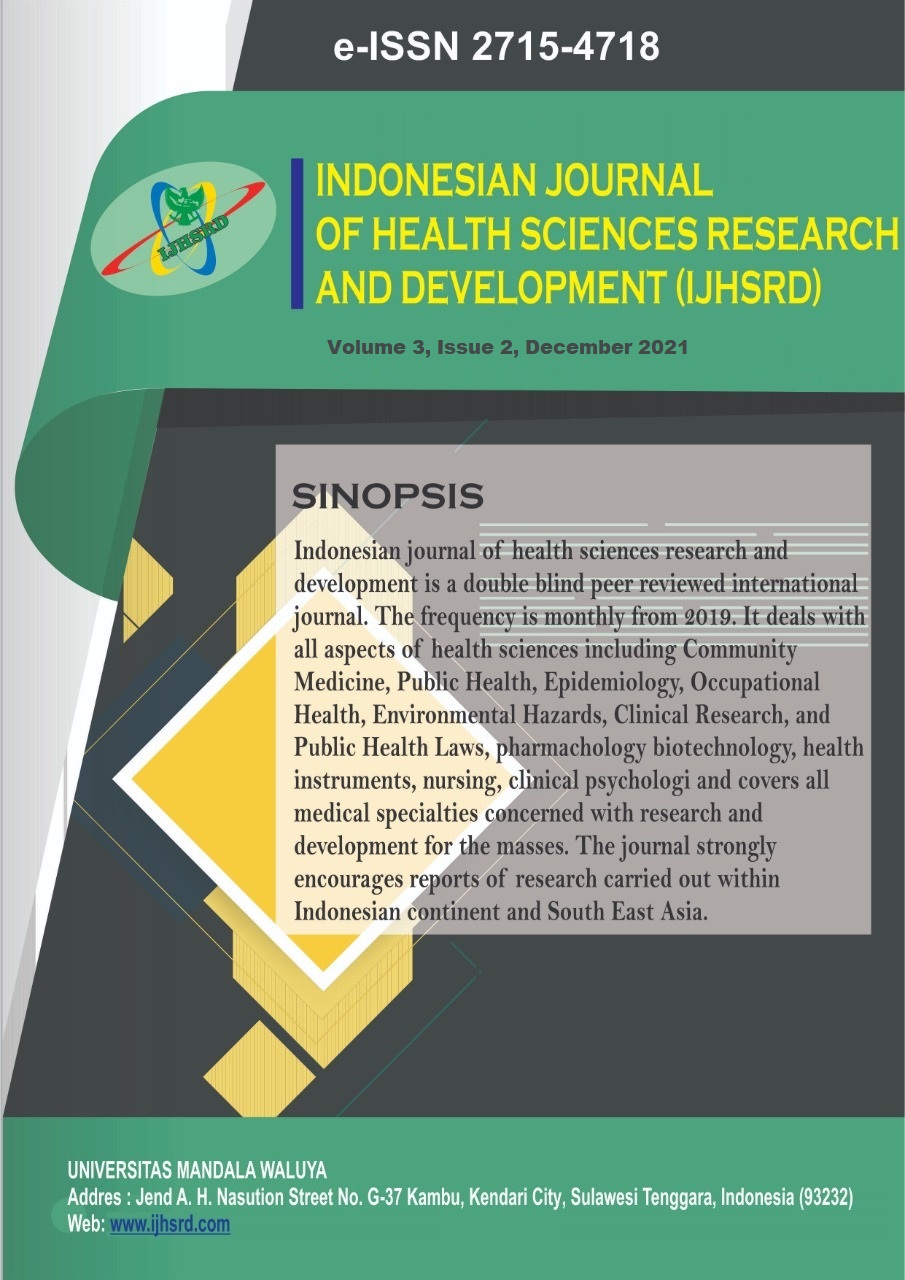Main Article Content
Abstract
Background: Malnutrition is the cause of one third of deaths in children. Nutritional Status Monitoring data in Muna Regency obtained 1,279 cases of stunting in toddlers aged 0-24 months and 1,397 cases in toddlers 24-59 months.The high incidence of stunting is caused by several factors. This research aims to analyzing risk factors for stunting in South Wakorumba District, Muna Regency, Southeast Sulawesi Province.
Methods: This type of research is a case control study conducted from March to April 2021,the sample used are 63 cases taken by simple random sampling and 63 controls.
Results: Using Odds Ratio (OR). OR value of family income is 0,294< 1, OR value of dietary habit is 0,323< 1, OR value of exclusive breastfeeding history is 0,327< 1, OR value of LBW history is 0,359< 1, and OR value of history of infection is 0,229< 1.
Conclusion: Family income, dietary habit, exclusive breastfeeding history, LBW history, and history of infection are risk factors of stunting incident in South Wakorumba District, Muna Regency, Southeast Sulawesi Province.
Keywords
Article Details

This work is licensed under a Creative Commons Attribution-ShareAlike 4.0 International License.
References
- Boggin B. Patterns of Human Growth (Cambridge Studies in Biological and Evolutionary Anthropology, Series Number 23). 2nd ed. English: Cambridge University Press; 1999.
- UNICEF. Undernutrition Contributes to Nearly Half of All Deaths in Children Under 5 and is Widespread in Asia and Africa. Geneva: World Health Organization; 2018.
- Timæus IM. Stunting and obesity in childhood: a reassessment using longitudinal data from South Africa. International journal of epidemiology. 2012;41(3):764–772.
- Southeast Sulawesi Provincial Health Office. Health Profile of Southeast Sulawesi Province 2019. Kendari; 2020.
- Muna District Health Office. Muna District Health Profile 2020. Muna: Muna District Health Office; 2021.
- Notoatmodjo S. Health Research Methods. Jakarta: Rineka Cipta; 2014.
- Sugiyono. Quantitative, Qualitative, and R&D Research Methods. Bandung: Alphabeta; 2019.
- Hermawan I. Educational Research Methodology: Qualitative, Quantitative, and. Mixed Method. Brass: Hidayatul Quran; 2019.
- Ngaisyah RD. Socio-economic relationship with the incidence of stunting in children under five in Kanigoro Village, Saptosari, Gunung Kidul. Medika Respati: Scientific Journal of Health. 2015;10(4):65–70.
- Chandra A, Puruhita N, Susanto JC. Risk factors of stunting among 1-2 years old children in Semarang City. Indonesian Medical Media. 2011;45(3):206–212.
- Suhardjo. Various Ways of Nutrition Education. Jakarta: Earth Literacy; 2016.
- Rasyid S, Jayadipraja EA. The Relationship Of Knowledge And Support Of Health Workers With The Achievement Of Latrine Using In Tirawuta Sub-District, East Kolaka District: Achievement Of Latrine. Indonesian Journal of Health Sciences Research And Development (IJHSRD). 2021;3(2):8–13.
- Sulistianingsih A, Sari R. Exclusive breastfeeding and birth weight affect stunting in toddlers 2-5 years in Pesawaran Regency. Indonesian Journal of Clinical Nutrition. 2018;15(2):45–51.
- Perdani ZP, Hasan R, Nurhasanah N. The relationship between feeding practices and the nutritional status of children aged 3-5 years in the Hearth of Tegal Kunir Village, Lor Mauk. Jkft Journal. 2017;1(2):9–17.
- Mufdlilah M. Guidelines For Empowerment Of Breastfeeding Mothers In Exclusive Breast Milk Program. Yogyakarta: University of Aisyiyah Yogyakarta; 2017.
- Indonesian Ministry of Health. Exclusive Breastfeeding for Babies. Jakarta: Indonesian Ministry of Health; 2016.
- Ni'mah K, Nadhiroh SR. Factors related to the incidence of stunting in toddlers. Indonesian Nutrition Media. 2015;10(1):13–19.
- Arifin DZ, Irdasari SY, Sukandar H. Analysis of distribution and risk factors for stunting in children under five in Purwakarta Regency 2012. Master's Program in Public Health Sciences, Faculty of Medicine, Padjadjaran University, Bandung. 2012;
- Wiyogowati C. Incidence of Stunting in Children Under Five Years of Age (0-5 Months) in West Papua Province in 2010 (Data Analysis of Riskesdas in 2010) [Thesis]. [Depok]: University of Indonesia; 2012.
- Swathma D, Lestari H, Ardiansyah RT. Analysis of LBW Risk Factors, Infant Body Length at Birth and Basic Immunization History on Stunting Incidence in Toddlers Age 12-36 Months in the Working Area of Kandai Health Center, Kendari City in 2016. (Scientific Journal of Public Health Students). 2016;1(3):1–10.
- Oktarina S, Fajar NA. Prediction Model of Neonatal Mortality in Purbolinggo District, East Lampung Regency, Lampung Province. Journal of Public Health Sciences. 2017;8(1):49–55.
- Gibney M, Kearney J. Public Health Nutrition. Jakarta: EGC; 2008.
- Dewi NT, Widari D. The relationship between low birth weight and infectious diseases with stunting in children under two in Maron Kidul Village, Maron District, Probolinggo Regency. Amrita Nutrition. 2018;2(4):373–381.
- Welasasih BD, Wirjatmadi RB. Several factors related to the nutritional status of stunting toddlers. The Indonesian Journal of Public Health. 2012;8(3):99–104.
